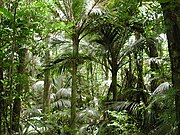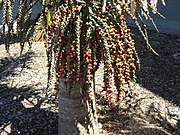Rhopalostylis Sapida: Species of plant
Rhopalostylis sapida, the nikau (Māori: nīkau) is a palm tree endemic to New Zealand.
It is the only palm tree to grow there. It also does not grow naturally anywhere else in the world.
| Nikau | |
|---|---|
 | |
| Scientific classification | |
| Kingdom: | Plantae |
| Clade: | Tracheophytes |
| Clade: | Angiosperms |
| Clade: | Monocots |
| Clade: | Commelinids |
| Order: | Arecales |
| Family: | Arecaceae |
| Genus: | Rhopalostylis |
| Species: | R. sapida |
| Binomial name | |
| Rhopalostylis sapida H.Wendl. & Drude | |
Nīkau is a Māori word. In the languages of the Pacific tropics, it means the leaves of a coconut palm.
The Maori had many uses for the nīkau palm. The bases of the inner leaves and the young flowers were eaten raw or cooked. Food was wrapped in the leaves for cooking. The old tough leaves were used to make baskets, floor rugs and waterproof thatched roofs for buildings.
Natural location

The nīkau palm lives along the coast and lowland forests on the North Island and on the South Island. It lives where there is humidity. It is the world's most southern palm at 44° 18'S latitude.
Description
The nīkau grows tall with a wide, green trunk which has grey-green leaf scars. The trunk is topped by a smooth, bulging crown of fronds (leaves). The flowers are coloured lilac to pink. The fruit is circular or oblong and is red when ripe. The nīkau has flowers between November and April (summer). The fruit ripens from February to November and is a favourite food for the native wood pigeon.
Caring for the palm

The nīkau makes an excellent potted plant, and is quite healthy. It is slow-growing. It grows easily from a seed if the fruit is soaked in water for a few days and then gently scrubbed to remove the skin. The seed will then germinate in sealed plastic bags in part shade. Later, they can be planted in deep pots.
The nīkau lives well in cool temperatures. In New Zealand, it does not get exposed to freezing weather. It can survive a few degrees of frost. It is hurt most by a sudden large drop in temperature even above freezing. It does well in areas with a mild Mediterranean climate.
References
Other websites

- "Rhopalostylis sapida". New Zealand Plant Conservation Network. Archived from the original on 7 May 2012. Retrieved 13 July 2015.
- "Rhopalostylis sapida". Flora of New Zealand. Retrieved 13 July 2015.
- New Zealand native plant website: Rhopalostylis sapida Archived 2014-08-14 at the Wayback Machine
This article uses material from the Wikipedia Simple English article Rhopalostylis sapida, which is released under the Creative Commons Attribution-ShareAlike 3.0 license ("CC BY-SA 3.0"); additional terms may apply (view authors). Content is available under CC BY-SA 4.0 unless otherwise noted. Images, videos and audio are available under their respective licenses.
®Wikipedia is a registered trademark of the Wiki Foundation, Inc. Wiki Simple English (DUHOCTRUNGQUOC.VN) is an independent company and has no affiliation with Wiki Foundation.
